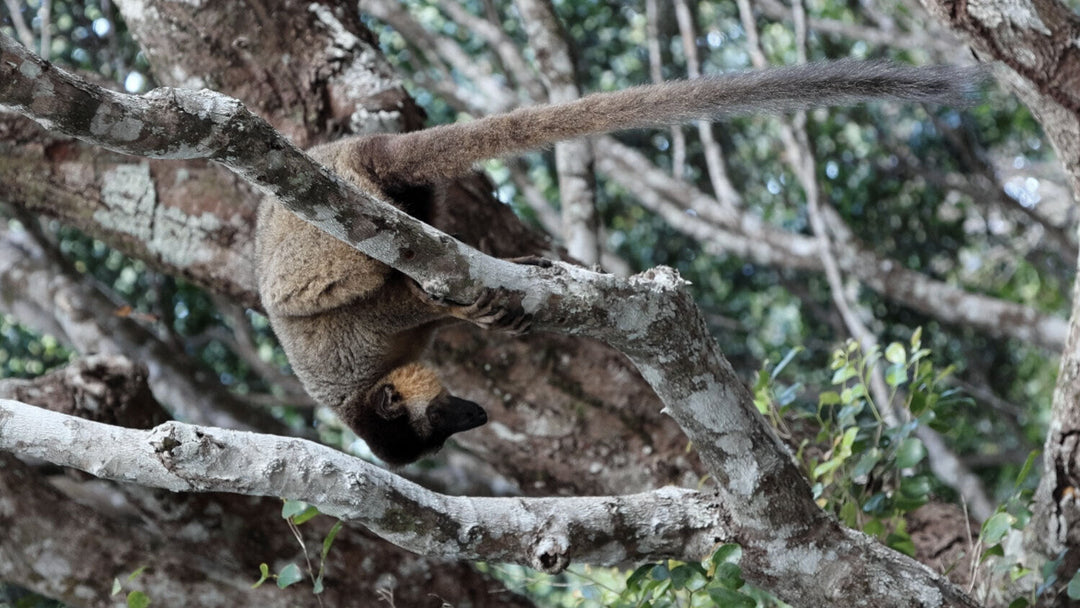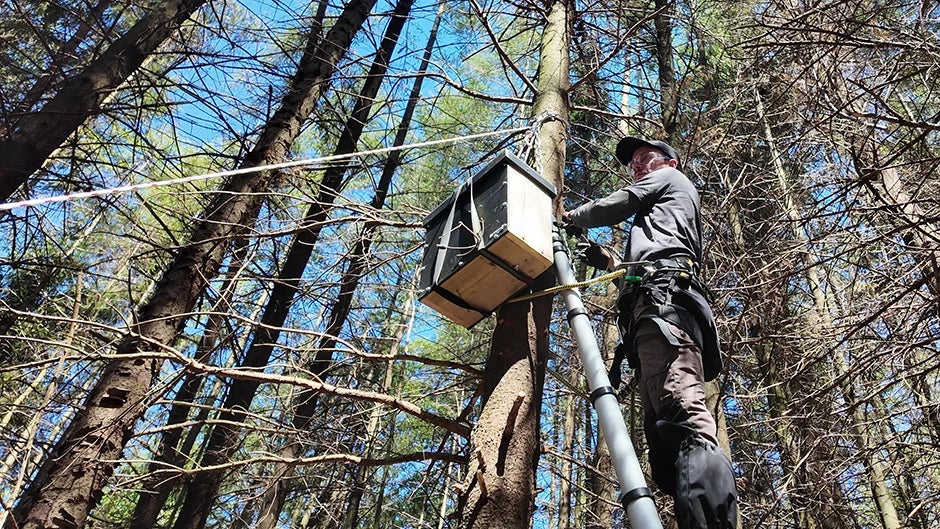Yorkshire Pine Marten Project update 2022
Over the past year we've begun work on a set of 5 pine marten conservation objectives on the North York Moors, feeding into our long-term vision to see pine martens in Yorkshire once again in healthy numbers. In this update we share our activity and findings over the past year...
Pine marten conservation in Yorkshire
Following on from the HLF funded Yorkshire Pine Marten Support Programme (2018-2021), NatureSpy created a Pine Marten Conservation Strategy for Yorkshire (2021-2024) in collaboration with Forestry England. Over the past year we’ve begun work on a set of conservation objectives, which maintain and develop aspects of our previous 3-year project. The overarching, long-term vision of our strategy is to establish self-sustaining populations of pine martens in Yorkshire as part of the national restoration of the species. Our current short-term objectives - running up to 2024 - include key aspects of the groundwork that needs to take place to realise this vision. This includes pine marten surveys, responding to and collating reported sightings, running a pine marten den box programme, public engagement and assessing the challenges that pine martens may face in the unique landscape of Yorkshire.
In this update report we summarise our activity and findings over the past year, from August 2021 to September 2022.

A view from Boltby Forest - North York Moors
2021/22 in summary
- Pine marten records continue to be few and far between in Yorkshire. This year we have 3 new confirmed records, compared to 1 confirmed record the previous year.
- We have gathered 9 reported sightings for the Yorkshire area from the public, which is an increase on the previous four years, where we have averaged 6 reported sightings per year.
- Although it is encouraging to see a rise in confirmed and reported records over the past year, the small number of records we’re gathering suggests that pine martens are continuing to live in very low numbers in Yorkshire and are not of sustainable, healthy population sizes.
- Den boxes have been a key focus of our work, making sure they’re installed in the most effective places and are monitored at the right times. This year we added 16 new den boxes into forests on the North York Moors, taking our total in the programme up to 46.
- We’ve been working on our project engagement, including an updated pine marten identification display in Dalby Forest visitor centre.
- We’ve begun work on research to assess factors that could harm pine marten population establishment and limit dispersal to and from the county.
Pine marten surveys and monitoring
Three new confirmed pine marten records
Pine martens are a challenging species to monitor due to their elusive behaviour and main times of activity being at night. Trail cameras are a great tool for monitoring the species as they enable an insight into forests 24/7. Over the past year we are pleased to report on two confirmed records of pine martens in Yorkshire from our camera survey work:
- Over a 10-week period from October to December 2021, our cameras picked up footage of a male pine marten – identified by his unique bib-fur pattern - at multiple sites on the North York Moors (click here to learn more about this footage).
- More recently, our cameras picked up several events of another male pine marten between August and September 2022 on the North York Moors.
In addition to our two trail camera records, a member of the public submitted a record and photograph of a deceased pine marten - believed to be roadkill - in southwest Yorkshire in June 2022.
How does this compare to previous years?
In 2020-2021 there were two confirmed records of pine martens in Yorkshire and the previous year (2019-2020) there were none. Although it is great to see a rise in confirmed records over the past few years, the small number of records we’re gathering suggests that pine martens are continuing to live in very low numbers in Yorkshire and are not of sustainable, healthy population sizes.
Our surveys
Trail cameras remain our main survey tool for pine martens in Yorkshire, with the North York Moors as our primary focus area for camera surveys, owing to previous records over the past 50 years and the large area of forested habitats across the moors. Over the past year we have had between 30-40 cameras operating at any given time, covering Forestry England forests that include: Dalby, Cropton, Langdale, Wykeham, Silton, Boltby and the many smaller woodlands across the moors. Our camera survey and monitoring approaches vary, with a combination of den box monitoring, structured surveys and responding to reported sightings with follow-up monitoring locations. We have been trialling other camera survey methods too, including specially designed pine marten feeding stations, which we’ve found to be successful with other pine marten survey work in Scotland (learn more about that here).

Pine marten recorded on a trail camera on the North York Moors in winter 2021.
Reported sightings
Confirming pine marten sightings without evidence (e.g. photographic or genetic) is challenging due to the risk of misidentification, as the species can be mistaken for other mustelids, including polecats, stoats and mink. For this reason, we use a standardised question set for any sightings reported, adapted from an existing scoring approach for pine marten sightings, enabling an understanding of the likelihood that the animal reported is a pine marten. For a full description of how we do this, see our Conservation Strategy.
We have gathered 9 reported sightings over the past year: 3 were rated as highly probable records due to the clarity of description and/or experience of reporter; 2 were rated as possible sightings due to a clear description and little-to-no confusion to suggest it could have been another species; 2 were considered unlikely to be pine marten records due to a lack of detail or an indication that it may have been a different species; and, 2 were not rated due to insufficient information provided.
How does this compare to previous years?
The 9 reported sightings we received this year is an increase on previous years, with an average of 6 reported sightings per year since we began collating sightings in 2017. As with the confirmed records, this is still a very low number, and certainly not one we can associate with healthy pine marten population sizes.
Have you seen a pine marten in Yorkshire?
Please let us know! Click here to report your sighting. Please include your name, location, date, time and a description of the animal you saw.
Den box programme
Den boxes provide a significant habitat enhancement for pine martens by providing safe, elevated resting and breeding sites. Natural, elevated denning sites are scarce in much of the forestry woodland on the North York Moors, as these younger trees tend not to provide many denning options in cavities that are more commonly found in more mature trees.
Pine marten den boxes have been a central focus of our work North York Moors since 2018. Over the past year we’ve installed a further 16 boxes, taking our total in operation to 46 that are monitored annually. Our den box programme can be broadly split into two patches: 30 den boxes on the more wooded east side of the moors in forests including Dalby, Langdale, Cropton and Wykeham; and, 16 den boxes on the west of the moors, including Ingleby Greenhow, Silton, Boltby and the many smaller woodlands across the area. 11 of our 16 new den box installations this year were on the west side of the moors, as this was identified as an area of moderately suitable habitat in the Vincent Wildlife Trust’s Long-term strategic recovery plan for pine martens in Britain. The installation of more den boxes on the west side of the moors provides an immediate boost to habitat quality for pine martens.
Our latest camera trap footage below, recorded in August and September 2022, shows a male pine marten prospecting three different den box sites.
Improving public awareness of pine martens
We’ve continued to develop our website resources via our dedicated Yorkshire Pine Marten Project web pages and earlier in 2022 we updated our pine marten display in Dalby Forest visitor centre. Dalby Forest continues to be one of Yorkshire’s most popular attractions and is an area of previous pine marten records. We’ve updated our visitor centre display to highlight the significance of seeing this rare species in Yorkshire. Our illustrations and descriptions are designed to help people identify pine martens when compared to other mustelid species and help us to gather reported sightings that build the evidence base for pine marten activity in the region.

A snippet from our updated mustelid identification display in Dalby Forest visitor centre.
Navigating the landscape
As part of the groundwork for considering any future translocations of pine martens to Yorkshire, we need a better understanding of the factors that could harm pine marten population establishment and limit dispersal of animals to and from Yorkshire. This year we began the research work that will help us gain a better understanding of how pine martens can safely navigate the landscape of the North York Moors and identify the types of challenges they may face in developing into sustainable populations. A better understanding of these factors will help to inform future pine marten conservation strategies in the region.
Continuing to work on our conservation strategy in 2022/23
Over the coming year we’ll be continuing to move forwards with our short-term conservation objectives: Our camera trap surveys will continue much as they have over the past year through a combination of more structured surveys and responses to reported sightings; we will continue to gather reported sightings, building the evidence base for pine marten activity in Yorkshire; our den box programme will be maintained through our annual monitoring plan; we will continue seeking opportunities to collaborate with people and organisations to improve public awareness of the species; and, our research work will continue, helping us to understand the factors that could harm pine marten population establishment and limit dispersal to and from the county.
Extra insights into wildlife...
Our main focus with our camera trap surveys in Yorkshire is of course capturing footage of pine martens - but we don't get to choose who visits our cameras! Over the past few years we've captured images of 60 different species (20 mammals and 40 birds) in forests across the North York Moors. We've created and submitted just shy of 15,000 wildlife records to date, thanks to our volunteers!
------
Article by Ed Snell
Learn more about the Yorkshire Pine Marten Project over on our project page

